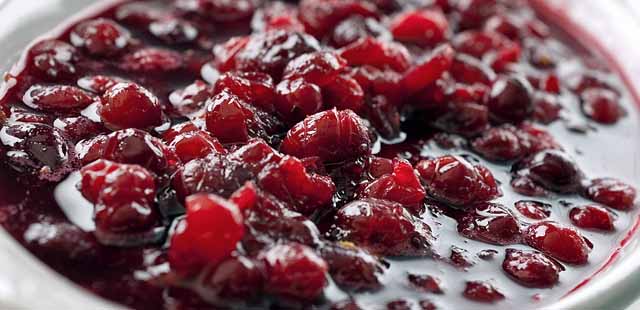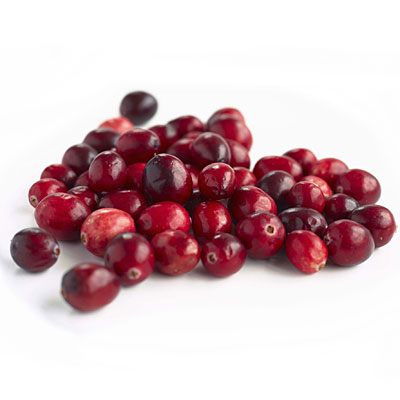
Serving cranberry sauce is a tradition during the holidays. However, cranberries are a superfood which can be enjoyed all year round.
The cranberry (Vaccinium macrocarpon) is related to the blueberry and huckleberry in the Vaccinium genus. It grows in acidic bogs throughout the US and Canada, particularly in New England, Washington, Oregon, northern California, and southwestern British Columbia. The plant resembles a dwarf, creeping shrub or vine with slender, wiry, woody stems bearing small, evergreen leaves and can reach 2 meters in length and 10-20 centimeters in height. The berry is initially white but turns to its characteristic scarlet color in July-August.
Fresh native American cranberries are sometimes called “bounceberries” because ripe ones bounce or “craneberries” due to their pale pink blossoms which resemble the heads of cranes that frequent cranberry bogs. A fruit with a short season, cranberries are harvested between Labor Day and Halloween and appear in markets from October through December. Besides adding a festive hue and tart tangy flavor to holiday meals, fresh cranberries offer numerous beneficial nutrients and health protective effects which peak during this season. Once cranberries’ short fresh season is past, unsweetened cranberry juice made from whole berries and dried or frozen cranberries are available to offer delicious health benefits every day throughout the year.
The ripe cranberry is a small, round, red berry with four centrally situated tiny seeds enclosed inside. The berry is very acidic in taste, having a ph in the range of 2.3 to 2.5.
How cranberries are harvested:
Many cranberries are water-harvested, i.e., grown in bogs and floated on the surface of the water to allow for easy harvesting. The anthocyanin content of cranberries (the phytonutrients that give the berries their red color) increases in direct proportion to the amount of natural sunlight received by the berry. If berries floating on top of water get exposed to increased amounts of natural sunlight (in comparison to other growing and harvesting conditions), they may develop greater concentrations of anthocyanins. These greater concentrations of anthocyanins are likely to provide stronger health benefits. Since water-harvesting tends to expose cranberries to more natural sunlight than other growing methods, greater phytonutrient health benefits may result from the antioxidant and anti-inflammatory properties of anthocyanins.
How to select and store:
- Choose fresh, plump cranberries, deep red in color, and firm to the touch.
- Firmness is a primary indicator of quality. In fact, during harvesting, high quality cranberries are often sorted from lesser quality ones by bouncing the berries against barriers made of slanted boards. The best berries bounce over the barriers, while the inferior ones collect in the reject pile.
- The deeper red their color, the more highly concentrated are cranberries’ beneficial anthocyanin compounds.
- Although typically packed in 12-ounce plastic bags, fresh cranberries, especially if organic, may be available in pint containers.
- Fresh ripe cranberries stored in the refrigerator are usually good for up to 2 weeks. Before storing, discard any soft, discolored, pitted or shriveled berries. When removed from the refrigerator, cranberries may look damp, but this moistness does not indicate spoilage, unless the berries are discolored, sticky, leathery, or tough.
- Fresh cranberries freeze well. To freeze, store them in their original plastic bag, without pre-washing, for up to one year. DO NOT THAW frozen cranberries before using. Simply rinse in cold water and use as directed for fresh cranberries. Frozen berries can be chopped in a food processor (one bag or 3 cups /750 mL at a time). Another way to freeze fresh cranberries is to spread them on a cookie sheet and place in the freezer. In a few hours, the fully frozen berries will be ready to place in a freezer bag. Date the bag before returning them to the freezer. Buy extra bags of fresh cranberries and freeze them for year-round use.
- Once thawed, frozen berries will be soft and should be used immediately.
- Dried cranberries are available at many markets with other dried fruits, but often include added sugar.
 For optimum health try to eat 5-10 servings of various fruits and vegetables each day.
For optimum health try to eat 5-10 servings of various fruits and vegetables each day.
Preparing cranberries:
- Treat fresh berries with care. Just prior to use, place them in a strainer and briefly and gently rinse under cool running water. Drain in a colander.
- When using frozen cranberries in recipes that do not require cooking, thaw well and drain prior to using. For cooked recipes, use unthawed berries, since this will ensure maximum flavor. Extend the cooking time a few minutes to accommodate for the frozen berries.
- Cranberries offer their maximum amount of nutrients and taste when eaten fresh and not prepared in a cooked recipe. That is because their nutrients, including vitamins, antioxidants*, and enzymes, cannot withstand the temperature normally used in baking (350°F/175°C).
Nutrition:
Native American cranberries are quite nutritious and known for being a good source of vitamin C. One-half cup (50.00 grams or 125 ml) of fresh cranberries contains 23-25 calories and the following recommended daily allowances: vitamins C (11%), E (4%), pantothenic acid (3%), K (2%), and A (1%); 2.3 grams of fiber (6%), minerals manganese (8%), copper (3.5%), and potassium (1%), plus many natural antioxidants.
Fresh cranberries contain no cholesterol, virtually no fat, and very little sodium. Fresh, as well as dried, berries contain the most antioxidants, while bottled cranberry drinks and cranberry cocktails with added sugars contain the least.
| (Principle) | (Nutrient Value) | (Percentage of RDA) |
|---|---|---|
| Energy | 46 Kcal | 2.3% |
| Carbohydrates | 12.2 g | 9% |
| Protein | 0.4 g | 1% |
| Total Fat | 0.13 g | <1% |
| Cholesterol | 0 mg | 0% |
| Dietary Fiber | 4.6 g | 12% |
| Vitamins | ||
| Folates | 1 µg | <1% |
| Niacin | 0.101 mg | 1% |
| Pantothenic acid | 0.295 mg | 6% |
| Pyridoxine | 0.057 mg | 4% |
| Riboflavin | 0.020 mg | 2% |
| Thiamin | 0.012 mg | 1% |
| Vitamin A | 60 IU | 2% |
| Vitamin C | 13.3 mg | 22% |
| Vitamin E | 1.20 mg | 8% |
| Vitamin K | 5.1 µg | 4% |
| Electrolytes | ||
| Sodium | 2 mg | 0% |
| Potassium | 85 mg | 2% |
| Minerals | ||
| Calcium | 8 mg | 1% |
| Copper | 0.061 mg | 7% |
| Iron | 0.25 mg | 3% |
| Magnesium | 6 mg | 1.5% |
| Manganese | 0.360 mg | 16% |
| Phosphorus | 13 mg | 2% |
| Selenium | 0.1 µg | 0% |
| Zinc | 0.10 mg | 1% |
| Phyto-nutrients | ||
| Carotene-ß | 36 µg | — |
| Crypto-xanthin-ß | 0 µg | — |
| Lutein-zeaxanthin | 91 µg | — |
- Use cranberries to replace vinegar or lemon when dressing green salads. Toss the greens with a little olive oil, then add color and zest with a handful of raw cranberries.
- Add dried cranberries to your favorite cereal
- Drink 100% fruit juice that includes cranberries
- Add cranberries to chicken and pork dishes
- To balance their extreme tartness, combine fresh cranberries with other fruits such as oranges, apples, pineapple, or pears. If desired, add some fruit juice, honey, or maple syrup to chopped fresh cranberries.
- For an easy-to-make salad that will become a holiday favorite, place 2 cups fresh berries in a blender with 1/2 cup pineapple chunks, a quartered skinned orange, 1 apple, and some walnuts or pecans. Blend till well mixed but still chunky. Transfer to a large bowl. Dice 3-4 stalks of celery and add to the cranberry mixture. Stir till just combined. Enjoy!
- Combine unsweetened cranberry juice in equal parts with your favorite fruit juice and sparkling mineral water for a lightly sweetened, refreshing spritzer. Garnish with a slice of lime.
- Add color and variety to your favorite recipes for rice pudding, quick breads or muffins by using dried cranberries instead of raisins.
- Sprinkle a handful of dried cranberries over a bowl of hot oatmeal, cream of wheat, or any cold cereal.
- Mix dried cranberries with lightly roasted nuts for a delicious snack.
Fresh, frozen, or dried cranberries may be added to the following for color and flavor:
- Pancakes and waffles
- Muffins and breads
- Fruit desserts, pies, pastries
- Smoothies
- Fruit juice blends
- Meat entrees
- Holiday stuffing
- Fruit and vegetable salads
- Jell-O salads
- Sauces for meat and sandwiches
- Cranberries contain oxalic acid, a substance naturally found in many fruits, vegetables, grains, nuts and seeds (ex., spinach, rhubarb, chard, beets, beet leaves, bananas, star fruit) which may crystallize as oxalate stones in the urinary tract in some individuals. People with a known history of oxalate urinary tract stones should limit intake of cranberries and, especially vegetables belonging within the Brassica family. Adequate water intake is advised to dilute and maintain normal urine output and reduce the risk of such stones. If you have kidney stones, consult your doctor before self-treating with cranberry juice or cranberry products.
- People taking Coumadin (Warfaran) should avoid or minimize eating cranberries, drinking cranberry juice, or taking cranberry containing herbal products. Cranberry products destabilize Coumadin and increase its anticoagulant effect on the body which increases the risk of severe bleeding problems. Avoid or drink only small amounts of cranberry juice when taking warfarin.
Medical disclaimer: The information on this website is intended solely for the general information for the reader. It is not to be used to diagnose specific health problems or for treatment purposes. It is not a substitute for medical care provided by a licensed and qualified health professional. Please consult your health care provider for any advice on medications.
* Antioxidants: Important compounds in plants which protect the body from “free radicals,” harmful oxidants in cigarette smoke, pollutants, unhealthy foods, and environmental toxins. Free radicals cause cell damage which weakens the immune system and may increase the risk of several diseases. Antioxidants reduce the effect of free radical oxidants by binding with them to decrease their destructive tendencies and repairing the damage already done. Research has shown that antioxidants help to maintain healthy cells, tissues, and arteries.
References:
- “Cranberries: #1 in Antioxidants and #1 in Proanthocyanidins (PACs).” USDA Oxygen Radical Absorbance Capacity (ORAC) of Selected Foods. 2007.
- “Cranberries-What’s New and Beneficial About Cranberries?” Whole Foods: The World’s Healthiest Foods. 2013. (Source: www.whfoods.com/genpage.php?tname=foodspice&dbid=145)
- Davis, Jeanie Lerche. “Cranberries: Year-Round Superfood. You Can Get the Antioxidant Benefits of Cranberries Long After the Holidays.” WebMD, Inc. Feature Archive. 2007. Reviewed on September 29, 2009.

Comments on this entry are closed.